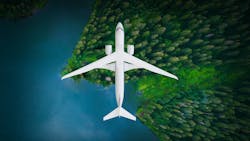Boeing takes delivery of MD-90 jet to be modified into NASA X-66A experimental aircraft
PALMDALE, Calif., - The Boeing Company in Arlington, Virginia, has moved an MD-90 single-aisle airliner from Victorville to Palmdale - both in California - where the comapny intends to develop the aircraft into the National Aeronautics and Space Administration's (NASA) newest "X-plane."
The X-66A is NASA's first experimental plane focused on helping the U.S. achieve its goal of net-zero aviation greenhouse gas emissions. Modification will begin soon and ground and flight testing is expected to begin in 2028. The X-66A will test the Transonic Truss-Braced Wing (TTBW) configuration as part of NASA's Sustainable Flight Demonstrator project.
With thin wings braced by struts with larger spans and higher-aspect ratios, the TTBW design and other expected technological advances could lead to reductions in fuel use and emissions by up to 30%. Boeing and NASA have collaborated for more than a decade on the concept through the Subsonic Ultra Green Aircraft Research (SUGAR) Program.
"This marks an important step in the Sustainable Flight Demonstrator project, advances Boeing's commitment to sustainability and brings us closer to testing and validating the TTBW design," said Boeing Chief Technology Officer Todd Citron.
Due to their heavy usage, single-aisle aircraft today account for nearly half of worldwide aviation emissions. Creating designs and technologies for a more sustainable version of this type of aircraft has the potential for profound impact on emissions.
NASA’s history with the X-plane designation dates to the 1940s, when its predecessor agency, the National Advisory Committee for Aeronautics (NACA) jointly created an experimental aircraft program with the Air Force and the U.S. Navy. The X-66A is the latest in a long line of NASA X-planes. Additionally, NASA’s Armstrong Flight Research Center in Edwards, California, has provided technical expertise and support for several additional X-planes.
For the Sustainable Flight Demonstrator, NASA has a Funded Space Act Agreement with Boeing through which the agency will invest $425 million over seven years, while the company and its partners will contribute the remainder of the funding, estimated at about $725 million. NASA also will contribute technical expertise and facilities.
